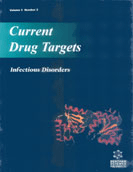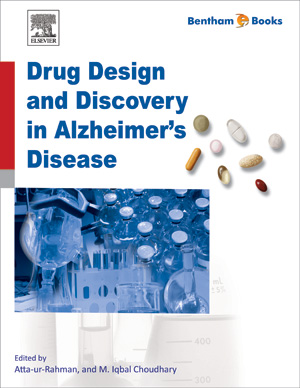Book Volume 5
Preface
Page: i-ii (2)
Author: Atta-ur-Rahman and M. Iqbal Choudhary
DOI: 10.2174/9789811432873120050001
List of Contributors
Page: iii-iv (2)
Author: Atta-ur-Rahman and M. Iqbal Choudhary
DOI: 10.2174/9789811432873120050002
Therapeutic Targeting of the Tumor Vasculature: Past, Present and Future
Page: 1-29 (29)
Author: Peace Mabeta, Mike Sathekge and Vanessa Steenkamp
DOI: 10.2174/9789811432873120050003
PDF Price: $30
Abstract
Tumor progression relies on a constant supply of oxygen and nutrients. Angiogenesis, the formation of neovessel from existing microvessels, is a prerequisite for the growth of many tumors. Significant advances have been made in delineating the interplay between pro- and anti-angiogenic factors that foster an environment that promotes the angiogenic phenotype in tumors. Of these angiogenic regulators, vascular endothelial growth factor-A (VEGF-A) and its cognate receptor, vascular endothelial growth factor receptor-2 (VEGFR-2) have been the most studied.
Various angiogenesis inhibitors (AIs) that target VEGF-A and VEGFR-2 have been developed for use as monotherapy or as part of combination therapies with standard chemotherapy. However, these AIs have thus far produced modest results, in part owing to compensatory pathways that have led to disease refractory.
To overcome refractory to disease, normalization of the tumor vasculature and broadening of the scope of therapeutic targeting are necessary. Furthermore, predictive biomarkers can enhance efficacy by enabling the early detection of resistance as well as the determination of clinical benefit. Herein, the therapeutic approaches that target multiple pathways and components of the tumor microenvironment, as well as those that normalize the vasculature are explored. In addition, the future application of noninvasive imaging to monitor the effects of AIs on the tumor vessels is discussed.
Anti-angiogenic Mechanism, Biochemical Factors’ Roles, Therapeutic Agents, and Under Clinical Trial Drugs for Breast and Prostate Cancers
Page: 30-85 (56)
Author: Varsha M. Singh, Shilpa J. Newati, Mohammad Yusuf, Alexandre Bridoux, Salman A. A. Mohammed, Naseem Akhtar and Riaz A. Khan
DOI: 10.2174/9789811432873120050004
PDF Price: $30
Abstract
The genesis of new blood vessels is the culmination of angiogenic activity which is responsible for the spreading of the tumors and other malignant masses. The blood supply also provides nourishment to non-malignant tissues and helps in their maintenance, growth, and proliferation. The major biological factors that significantly favor the angiogenic processes includes vascular endothelial growth factors (VEGFs), tumor necrosis factors (TNFs), and fibroblast growth factors (FGFs). The disruption and inhibition of angiogenic growth factors and their biochemical pathways during the cancer cycle are among the obvious choices to control the growth and proliferation of cancers. The current work deals in details about the growth factors, their roles, contextual biomechanics, and approaches to control angiogenesis through different inhibitory mechanisms involving biochemical pathways, growth factors, and structural motifs, playing part in the angiogenesis. The approaches to find novel molecular templates, new chemical entities, bio-macromolecular substrates, and probable drug leads for anti-angiogenic pharmacology are discussed. The chapter enlists various antiangiogenesis drugs, under clinical trials, new chemical entities, and other biochemical and recombinant therapeutic agents, used either as mono or as combination therapy in treatment of various forms of cancers, especially breast and prostate cancers.
Microbe-based Antiangiogenesis Therapies for Cancer Management
Page: 86-124 (39)
Author: Samman Munir, Usman Ali Ashfaq, Asad Ali Shah, Muhammad Shahid, Muhammad Sajid Hamid Akash and Mohsin Khurshid
DOI: 10.2174/9789811432873120050005
PDF Price: $30
Abstract
The recent scientific advancements have aroused the attention towards the role of microbes in the therapeutic management of various maladies that have transformed the pharmaceutical research. Although certain bacteria are widely known to cause cancer, recent research has shown exciting outcomes signifying the role of bacteria as an effective therapeutic agent for cancer. Different bacterial strains have been scrutinized for their inherent potentials to colonize the tumors environment and subsequent oncolytic properties in animal models. Moreover, their inherent anti-cancer properties can be boosted through genetic engineering, which allows the bacterial species to transfer the therapeutic molecules into tumor cells. During the previous few years, the studies have focused on the use of genetically modified bacteria for cancer therapy with an emphasis on blocking tumor angiogenesis. Although the studies regarding the microbial-based anti-angiogenesis therapy for cancer management are quite a few, it seems to be an innovative and attractive approach, particularly for solid tumors which usually possess increased vascularization. This chapter aimed to provide recent information relating to the candidates for anti-angiogenesis therapy, including angiostatin, tumstatin, endostatin, interleukin-12, metargidin peptide with a focus on recent developments in the newly identified field of microbe-based angiogenesis suppression. The advanced approaches for the use of modified bacteria as anti-cancer therapeutics have been discussed, particularly the DNA vaccination, bactofection, alternative gene therapy, and RNA interference with an emphasis on their antiangiogenesis potential.
Novel Anti-angiogenic Strategies in Cancer Drug Development
Page: 125-150 (26)
Author: Hoorieh Soleimanjahi and Ala Habibian
DOI: 10.2174/9789811432873120050006
PDF Price: $30
Abstract
Cancer, which is a complex disease of various types, is the most important health problem in modern life. Several conventional methods such as chemotherapy, radiotherapy and surgery have been adapted to fight against tumors. Nevertheless, recent studies revealed that tumors may acquire resistance against a variety of therapies based on the physiological state known as microenvironment. Tumor microenvironment is formed by different types of normal, inflammatory and immune cells, as well as blood vessels, which are efficient nutrient providers for the different types of tumors. Vascular endothelial growth factor (VEGF) is a tumor growth inducer that plays a crucial role in angiogenesis; besides, it contributes to the development of resistance against common therapies.
Anti-angiogenesis therapy has emerged as an approach to overcome the challenges of tumor therapy. It has been suggested that a combination of new strategies and conventional therapies may help in more efficient inhibition of tumor growth. Various approaches were designed to restrict the expansion of tumors. For instance, angiogenesis mechanisms trigger VEGF to inhibit tumor growth. Also, VEGF activation can be repressed by suppression of some signaling pathways such as RAS, MAPK, and PI3KAKT.
Besides the mentioned strategies, mesenchymal stem cells (MSCs) were introduced as a vehicle to deliver anti-angiogenic agents to tumors. In fact, some limitations that exist with anti-angiogenesis agents such as short endurance as the most important one, led to their application along with MSCs. Another way to suppress angiogenesis and tumor expansion is the application of MSCs-derived exosomes. These nanovesicles could down-regulate VEGF function by some special class of RNAs called miRs, as an antiangiogenic strategy in cancer therapy. Another strategy that was recently applied in this context is using oncolytic viruses.
Different kinds of virus families may be utilized as oncolytic viruses to selectively replicate in tumor cells. Reovirus, adenovirus, herpes simplex virus, measles virus, and vesicular stomatitis virus are examples of oncolytic viruses. Oncolytic characteristics of some viruses such as reovirus, make them potentially beneficial agents for curing tumors. Since reovirus is a benign virus for humans, its oncolytic properties are demonstrated more importantly in clinical settings. This kind of oncolytic virus may inhibit angiogenesis by Reolysin. In fact, interferon-γ-inducible protein 10 (IP-10), a member of the C-X- C chemokine family, which is also called CXCL10, is a target for Reolysin to induce anti-angiogenic activity. This anti-angiogenic chemokine is active both in wild type and Ras mutant cells.
This chapter demonstrates the potential activity of anti-angiogenesis agents in the prevention of tumor growth and cancer progression, with a particular focus on powerful regulators that were demonstrated to play crucial roles in cancer suppression by reengineering tumor microenvironment.
Angiogenesis and Chromene-based Antiangiogenic Therapeutic Agents
Page: 151-188 (38)
Author: Olivia Pontes, Ana Raquel-Cunha, Sofia Oliveira-Pinto, Fatima Baltazar, Olga Martinho and Marta Costa
DOI: 10.2174/9789811432873120050007
PDF Price: $30
Abstract
Tumor vascularization plays an essential role in cancer progression. Tumor vasculature provides oxygen and nutrients to cancer cells and removes waste products which is important for the rapid growth of tumors. Importantly, the tumor associated vessels are also used for tumor cell metastization, in which cancer cells invade distant organs. Therefore, inhibition of angiogenesis constitutes one of the elected targeted approaches for cancer treatment.
The first FDA approved antiangiogenic drug was bevacizumab, an antibody against vascular endothelial growth factor (VEGF) that has been used to treat metastatic tumors. However, despite the initial increase in survival rates, no major benefit in global survival was described and patients ended up relapsing due to acquired resistance. Further, monotherapy with this type of agents is not generally associated with improvement of survival, being antiangiogenic therapy a strategy that is worth pursuing as combination therapy. Thus, the efficacy of angiogenesis inhibitors is still a major challenge.
Several families of naturally occurring compounds have been described as antiangiogenic agents with promising results, such as stilbenes, chalcones, terpenoids, phenylethanoids and others. Due to their remarkable structure variety, plant polyphenols have been extensively studied and found to inhibit angiogenesis and metastasis through the regulation of multiple signaling pathways involved in cancer development. Chromenes and coumarins, such as crolibulin (EPC2407), have already been identified as vascular disrupting agents with promising antiangiogenic properties. The substitution pattern highly influences the activity and mode of action in various types of cancer. Specifically, chromenes are found to regulate the expression of VEGF, matrix metalloproteinases (MMPs) and receptor tyrosine kinases RTKs (e.g. EGFR) signaling pathways.
This chapter focuses on the antiangiogenic properties of chromenes, coumarins and derivatives, highlighting the recent progress in drug development and clinical applications.
Subject Index
Page: 189-198 (10)
Author: Atta-ur-Rahman and M. Iqbal Choudhary
DOI: 10.2174/9789811432873120050008
Introduction
The inhibition of angiogenesis is an effective mechanism of slowing down tumor growth and malignancies. The process of induction or pro-angiogenesis is highly desirable for the treatment of cardiovascular diseases, and wound healing disorders. Efforts to understand the molecular basis, both for inhibition and induction, have yielded fascinating results. Anti-angiogenesis Drug Discovery and Development provides an excellent compilation of well-written reviews on various aspects of the anti-angiogenesis process. These reviews have been contributed by leading practitioners in drug discovery science and highlight the major developments in this exciting field in the last two decades. The feast of these reader-friendly reviews on topics of great scientific importance – many of which are considered significant medical breakthroughs, makes this series excellent reading both for the novice as well as for expert medicinal chemists and clinicians. The fifth volume brings together reviews on the following topics: - Targeted therapy for tumor vasculature - Anti-angiogenic therapy for breast and prostate cancers (including information updates on clinical trials) - Microbe-based and other novel antiangiogenesis therapies such as chromene-based agents






















